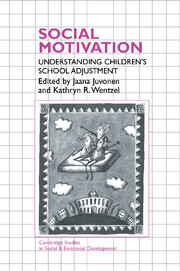Book contents
- Frontmatter
- Contents
- Contributors
- Preface
- Foreword
- 1 Introduction: New perspectives on motivation at school
- Part I Social motivation: Perspectives on self
- Part II Social motivation: Perspectives on relationships
- 9 Interpersonal relationships in the school environment and children's early school adjustment: The role of teachers and peers
- 10 Social goals and social relationships as motivators of school adjustment
- 11 Friends' influence on school adjustment: A motivational analysis
- 12 Peer networks and students' classroom engagement during childhood and adolescence
- 13 Academic failure and school dropout: The influence of peers
- 14 What's “emotional” about social motivation? A comment
- Author index
- Subject index
14 - What's “emotional” about social motivation? A comment
Published online by Cambridge University Press: 22 October 2009
- Frontmatter
- Contents
- Contributors
- Preface
- Foreword
- 1 Introduction: New perspectives on motivation at school
- Part I Social motivation: Perspectives on self
- Part II Social motivation: Perspectives on relationships
- 9 Interpersonal relationships in the school environment and children's early school adjustment: The role of teachers and peers
- 10 Social goals and social relationships as motivators of school adjustment
- 11 Friends' influence on school adjustment: A motivational analysis
- 12 Peer networks and students' classroom engagement during childhood and adolescence
- 13 Academic failure and school dropout: The influence of peers
- 14 What's “emotional” about social motivation? A comment
- Author index
- Subject index
Summary
Reading the chapters for this section of Social motivation: Understanding children's school adjustment reminded me of an incident that occurred about ten years ago when my older son was beginning middle school. With some apprehension, I was sitting in the audience at the parent orientation meeting, wondering whether I had made the right decision in allowing him to attend such an academically competitive private school. The headmaster approached the podium, scanned the sea of nervous-looking faces, smiled, and then said: “Relax, parents. We know that there are only two questions your son or daughter will be asking this year: “Where's my pencil and who's my best friend?”.
The insights of this headmaster reflect a common theme underlying the five chapters in this section of Juvonen and Wentzel's edited volume. That theme is that the academic outcomes of children and adolescents are integrally related to their social outcomes. Thus, the motivational psychologist concerned with individual achievement strivings also needs to examine how social relationships and affiliative concerns influence these strivings.
Although the specific outcome examined and scope of the coverage are quite disparate in the various chapters, each in some way is concerned with social influences on individual motivation. Beginning when children first enter school, Birch and Ladd (Chapter 9) describe the young child's relationship with his or her teacher as a determinant of academic adjustment. Relationships characterized by intimacy, nondependency, and the absence of conflict appear to facilitate the young child's adaptation to the academic environment, particularly during the transition from kindergarten to elementary school.
- Type
- Chapter
- Information
- Social MotivationUnderstanding Children's School Adjustment, pp. 346 - 360Publisher: Cambridge University PressPrint publication year: 1996
- 1
- Cited by

